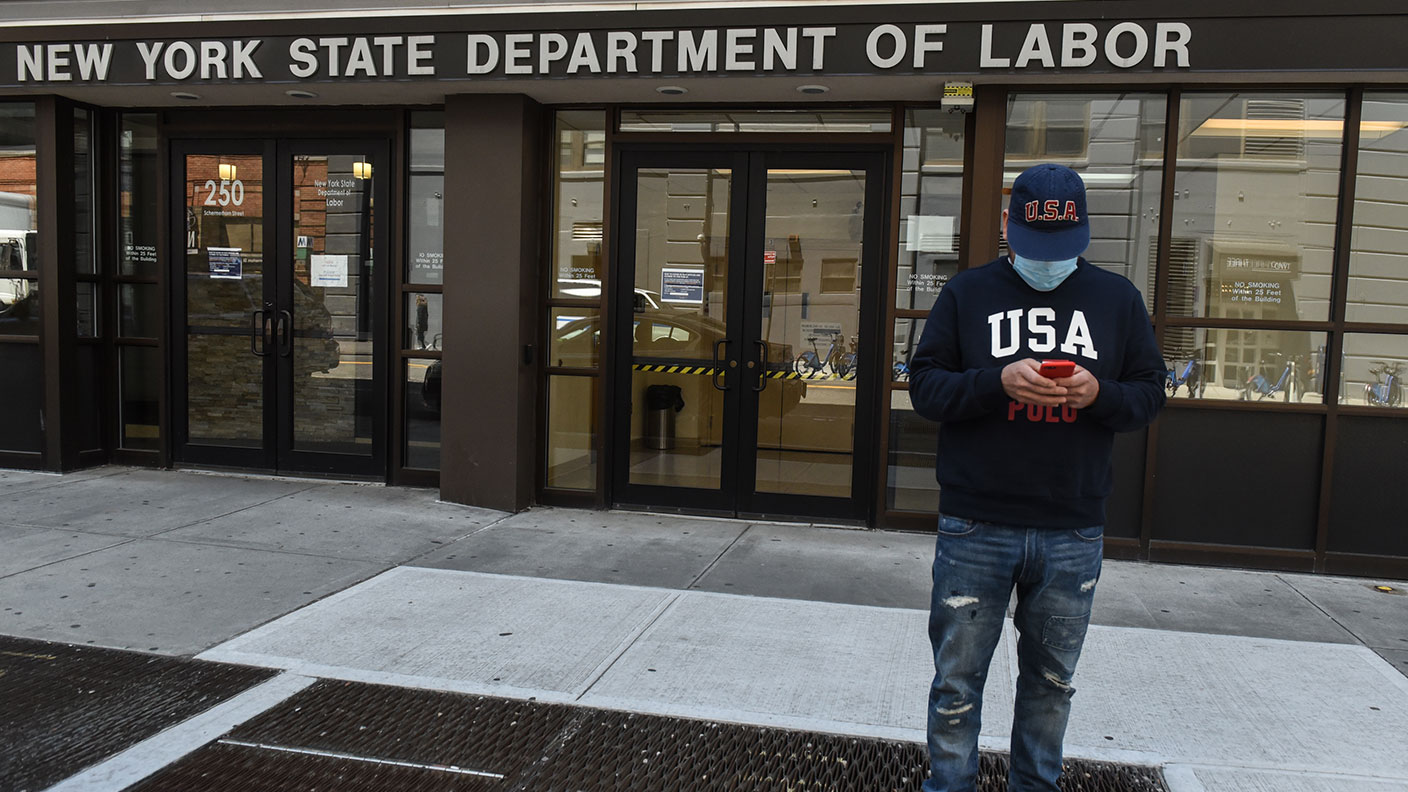For how long can stockmarkets ignore rising unemployment?
US unemployment figures are looking terrible – up to 20 million people have lost their jobs. But markets don’t seem to care. John Stepek explains what’s going on.


Last month, the US unemployment rate rose to close to 20%. Roughly 20.5 million people lost their jobs, according to the latest non-farm payrolls report.
It’s only got worse since then. These sorts of employment losses are unheard of. It makes 2008 look like a blip. And these are the sorts of reports we’re seeing in developed economies across the globe.
Can this level of unemployment really co-exist with such an apparently exuberant stockmarket?
MoneyWeek
Subscribe to MoneyWeek today and get your first six magazine issues absolutely FREE

Sign up to Money Morning
Don't miss the latest investment and personal finances news, market analysis, plus money-saving tips with our free twice-daily newsletter
Don't miss the latest investment and personal finances news, market analysis, plus money-saving tips with our free twice-daily newsletter
The unemployment figures are truly awful
The non-farm payrolls report comes out every month in the US. It’s usually a really important data point. It tells us what’s going on with employment and wages in the world’s biggest economy, after all.
This month it’s a bit more of an afterthought. The sheer scale of the damage wrought by the coronavirus means the numbers themselves are hard to comprehend (how do you price in the difference between 20 million and 19 million, say?). The weekly jobless claims figures are more timely, and looking at those, Capital Economics reckons that official unemployment is heading closer to 30%.
The damage is broad-based too. Leisure and hospitality was hardest hit, as you’d expect. Employment in that sector has almost halved since February. But education and health took a hit too (perhaps a bit surprising), as did retail (not at all surprising), and public sector employment (because of school closures).
The good news – inasmuch as there is any – is that most of this unemployment rise is still classified as temporary. And many states are now trying to re-open for business. So it’s possible that many of these people will be able to return to work in the relatively near future.
The key question at that point is: how much work will there be to return to? And that’s probably the main risk from an investment point of view.
There’s only so long that you can keep an economy in deep freeze before parts of it start to die off, regardless of how careful you are in conducting the initial cryogenics. Government help can go a long way, but even though we’re edging towards unlimited money printing, there’s still some wariness of going all-out for broke.
For example, returning to the UK, there are reports that the chancellor, Rishi Sunak, is looking at extending the government’s plan to pay for part of the wages of “furloughed” employees from the end of July until September (apparently we might get confirmation today). But from that point the government would only cover 60% of the wage bill.
It’s understandable that the government is looking to cut back. Something like a quarter of Britain’s private sector workforce is currently on furlough, which is costing the government a fortune. But it means that some tough choices are coming.
Being laid off temporarily with 80% of your wages being paid is a situation most people can cope with. It will be tougher for some than for others, but some might even welcome it, particularly if their spending has fallen during lockdown in any case.
However, getting that cut to 60% becomes significantly tougher, particularly as it follows hard on the heels of three months with an already-diminished wage. It also starts to raise some tough questions for the companies involved: are these employees ever coming back? Or has the firm simply taken too big a hit?
We’ve already seen the airlines making redundancies and I’d expect to start seeing that spread through other sectors over the coming months. This is when we start moving from the storyline that “the economy has been put into deep freeze” to realising that some of this damage is permanent (or at least, we can’t go straight back to “normal” after a few months).
Markets are not the economy – but still…
What does all of this mean from an investment point of view?
Rising unemployment is bad news for an economy, particularly one that depends on consumer spending (not to mention buoyant house prices).
If people don’t have jobs then they don’t have as much (if any) disposable income. If they don’t have disposable income, they don’t buy stuff. If they don’t buy stuff, companies don’t make profits or hire people – which in turn entrenches unemployment.
So it’s a vicious cycle. Obviously at some point that turns around when the economy hits rock bottom. But in the meantime it’s ugly. And it creates an environment in which more and more of the loans made to support companies now will end up going bad in the longer run, because there simply isn’t the demand to keep them afloat.
That said, like it or not, as we’ve often pointed out, stockmarkets are not the economy. And whatever else happens, it’s clear that central banks have acted more rapidly than ever before to underwrite the banking sector, and they have also made it clear that they will continue to print money if things don’t go their way.
For example, it's pretty clear that the Bank of England is keen to do even more quantitative easing (QE) at its next meeting.
The liquidity has to go somewhere. And with “tail risks” (the risk that a bank or some other systemically important institution goes bust and takes the entire market with it) being eliminated across the board by central banks, that does point to markets remaining propped up, even if those highs seem artificial or almost offensively oblivious to you as an individual investor.
Bear in mind that in 2009, markets bottomed well before the economic carnage of the recession had ended.
In any case, for now, there’s not much I can say except to stick to your investment plan (or get one if you haven’t got one). And do own some gold in your portfolio – the flip side of all this money printing is that it becomes politically harder to stop doing it when and if it becomes feasible to do so.
(We write a lot more about this in the current issue of MoneyWeek magazine – subscribe now to get your first six issues free, plus a free ebook on previous booms and busts).
Get the latest financial news, insights and expert analysis from our award-winning MoneyWeek team, to help you understand what really matters when it comes to your finances.
John Stepek is a senior reporter at Bloomberg News and a former editor of MoneyWeek magazine. He graduated from Strathclyde University with a degree in psychology in 1996 and has always been fascinated by the gap between the way the market works in theory and the way it works in practice, and by how our deep-rooted instincts work against our best interests as investors.
He started out in journalism by writing articles about the specific business challenges facing family firms. In 2003, he took a job on the finance desk of Teletext, where he spent two years covering the markets and breaking financial news.
His work has been published in Families in Business, Shares magazine, Spear's Magazine, The Sunday Times, and The Spectator among others. He has also appeared as an expert commentator on BBC Radio 4's Today programme, BBC Radio Scotland, Newsnight, Daily Politics and Bloomberg. His first book, on contrarian investing, The Sceptical Investor, was released in March 2019. You can follow John on Twitter at @john_stepek.
-
 The best and worst performing UK stocks of 2025 as FTSE 100 approaches record year
The best and worst performing UK stocks of 2025 as FTSE 100 approaches record yearThe blue-chip index is heading for another top year despite investors steering clear of UK equity funds
-
 Which sectors are best to invest in for 2026?
Which sectors are best to invest in for 2026?Investment trust portfolio managers give their views on the sectors and regions they expect to outperform in 2026.
-
 UK wages grow at a record pace
UK wages grow at a record paceThe latest UK wages data will add pressure on the BoE to push interest rates even higher.
-
 Trapped in a time of zombie government
Trapped in a time of zombie governmentIt’s not just companies that are eking out an existence, says Max King. The state is in the twilight zone too.
-
 America is in deep denial over debt
America is in deep denial over debtThe downgrade in America’s credit rating was much criticised by the US government, says Alex Rankine. But was it a long time coming?
-
 UK economy avoids stagnation with surprise growth
UK economy avoids stagnation with surprise growthGross domestic product increased by 0.2% in the second quarter and by 0.5% in June
-
 Bank of England raises interest rates to 5.25%
Bank of England raises interest rates to 5.25%The Bank has hiked rates from 5% to 5.25%, marking the 14th increase in a row. We explain what it means for savers and homeowners - and whether more rate rises are on the horizon
-
 UK inflation remains at 8.7% ‒ what it means for your money
UK inflation remains at 8.7% ‒ what it means for your moneyInflation was unmoved at 8.7% in the 12 months to May. What does this ‘sticky’ rate of inflation mean for your money?
-
 Would a food price cap actually work?
Would a food price cap actually work?Analysis The government is discussing plans to cap the prices of essentials. But could this intervention do more harm than good?
-
 Is my pay keeping up with inflation?
Is my pay keeping up with inflation?Analysis High inflation means take home pay is being eroded in real terms. An online calculator reveals the pay rise you need to match the rising cost of living - and how much worse off you are without it.
